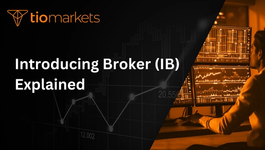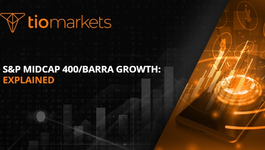Cyclically adjusted price-to-earnings ratio: Explained | TIOmarkets
BY TIOmarkets
|July 4, 2024The Cyclically Adjusted Price-to-Earnings ratio, commonly known as CAPE, Shiller P/E, or P/E 10, is a valuation measure that uses real earnings per share (EPS) over a 10-year period to smooth out fluctuations in corporate profits caused by business cycles. This article provides an in-depth explanation of the CAPE ratio, its calculation, interpretation, and its application in trading.
Developed by Nobel laureate economist Robert Shiller, the CAPE ratio is considered a better measure of a company's long-term fundamental value as it eliminates the short-term volatility of a company's earnings. It is a widely used indicator in trading, particularly in equity markets, to determine whether a stock is undervalued or overvalued.
Understanding the CAPE Ratio
The CAPE ratio is a variant of the traditional Price-to-Earnings (P/E) ratio, but with a twist. While the traditional P/E ratio considers the earnings of the past 12 months, the CAPE ratio takes into account the earnings of the past 10 years. This is done to account for the cyclicality of the economy and to provide a more accurate picture of a company's earning potential.
By considering a longer time frame, the CAPE ratio smooths out short-term fluctuations and anomalies in a company's earnings caused by economic cycles. This makes it a more reliable indicator of a company's true earning potential and fundamental value.
Calculation of the CAPE Ratio
The CAPE ratio is calculated by dividing the current market price of a stock by the average of ten years of earnings, adjusted for inflation. The formula for the CAPE ratio is as follows:
CAPE Ratio = Real Market Price per Share / (Average of 10 Years of Real EPS)
The 'Real Market Price per Share' is the current market price of the stock. The 'Average of 10 Years of Real EPS' is the average of the company's earnings per share for the past 10 years, adjusted for inflation.
Interpretation of the CAPE Ratio
The CAPE ratio is a relative valuation measure, meaning it should be used to compare the valuation of different companies or the same company over different periods. A high CAPE ratio could indicate that the stock is overvalued, while a low CAPE ratio could suggest that the stock is undervalued.
However, the CAPE ratio should not be used in isolation. Other factors such as the company's growth prospects, the overall state of the economy, and the interest rate environment should also be considered when making investment decisions.
Application of the CAPE Ratio in Trading
The CAPE ratio is a valuable tool for traders, particularly those who focus on long-term investments. It can be used to identify potential investment opportunities and to assess the risk and reward of an investment.
For example, a trader might use the CAPE ratio to identify stocks that are undervalued compared to their historical average. These could be potential investment opportunities. Similarly, a trader might use the CAPE ratio to assess whether the overall market is overvalued or undervalued, which could inform their trading strategy.
Using the CAPE Ratio to Identify Investment Opportunities
One of the main uses of the CAPE ratio in trading is to identify potential investment opportunities. By comparing a company's current CAPE ratio to its historical average, a trader can get a sense of whether the company is undervalued or overvalued.
For example, if a company's current CAPE ratio is significantly lower than its historical average, it could suggest that the company is undervalued. This could be a potential investment opportunity. However, it's important to remember that the CAPE ratio is just one indicator and should not be used in isolation.
Using the CAPE Ratio to Assess Market Conditions
The CAPE ratio can also be used to assess the overall state of the market. By comparing the current CAPE ratio of a market index, such as the S&P 500, to its historical average, a trader can get a sense of whether the market is overvalued or undervalued.
For example, if the current CAPE ratio of the S&P 500 is significantly higher than its historical average, it could suggest that the market is overvalued. This could indicate that a market correction or downturn is on the horizon, which could inform a trader's strategy.
Limitations of the CAPE Ratio
While the CAPE ratio is a valuable tool for traders, it's not without its limitations. One of the main criticisms of the CAPE ratio is that it can remain high or low for extended periods, which can lead to false signals.
For example, if a company's CAPE ratio is high, it could suggest that the company is overvalued. However, the CAPE ratio could remain high for several years before a market correction occurs. This could lead a trader to miss out on potential gains.
Changes in Accounting Standards
Another limitation of the CAPE ratio is that it doesn't take into account changes in accounting standards. Over the past several decades, there have been significant changes in the way companies report their earnings. These changes can affect a company's reported earnings and, consequently, its CAPE ratio.
For example, changes in the way companies account for depreciation can affect their reported earnings. If a company changes its depreciation method, it could result in a higher or lower reported earnings, which could affect its CAPE ratio.
Changes in Market Conditions
The CAPE ratio also doesn't take into account changes in market conditions. For example, during periods of low interest rates, companies can borrow cheaply, which can boost their earnings and lower their CAPE ratio.
However, if interest rates rise, companies might not be able to sustain their high earnings, which could result in a higher CAPE ratio. Therefore, it's important for traders to consider the overall market conditions when using the CAPE ratio.
Conclusion
The CAPE ratio is a valuable tool for traders, particularly those who focus on long-term investments. It provides a more accurate picture of a company's earning potential and fundamental value by smoothing out short-term fluctuations in earnings.
However, like any financial indicator, the CAPE ratio is not without its limitations. It's important for traders to use the CAPE ratio in conjunction with other financial indicators and to consider the overall market conditions when making investment decisions.
Start Trading with the Insight of CAPE Ratio
Now that you understand the significance of the Cyclically Adjusted Price-to-Earnings ratio in making informed trading decisions, it's time to put that knowledge into action. Join TIOmarkets, a top-rated forex broker, and access a comprehensive trading platform where you can apply the CAPE ratio to over 300 instruments across 5 markets. With low fees and a wealth of educational resources, TIOmarkets empowers you to trade Forex, indices, stocks, commodities, and futures markets effectively. Open your trading account today and be part of the 170,000+ traders in over 170 countries who are already navigating the financial markets with confidence. Create a Trading Account and start your journey with TIOmarkets.

Risk disclaimer: CFDs are complex instruments and come with a high risk of losing money rapidly due to leverage. You should consider whether you understand how CFDs work and whether you can afford to take the high risk of losing your money. Never deposit more than you are prepared to lose. Professional client’s losses can exceed their deposit. Please see our risk warning policy and seek independent professional advice if you do not fully understand. This information is not directed or intended for distribution to or use by residents of certain countries/jurisdictions including, but not limited to, USA & OFAC. The Company holds the right to alter the aforementioned list of countries at its own discretion.
Join us on social media

Behind every blog post lies the combined experience of the people working at TIOmarkets. We are a team of dedicated industry professionals and financial markets enthusiasts committed to providing you with trading education and financial markets commentary. Our goal is to help empower you with the knowledge you need to trade in the markets effectively.





